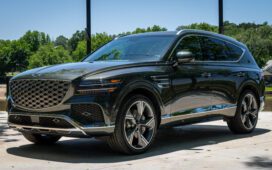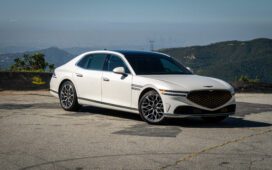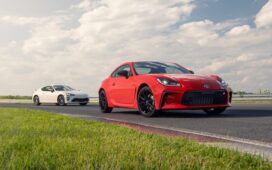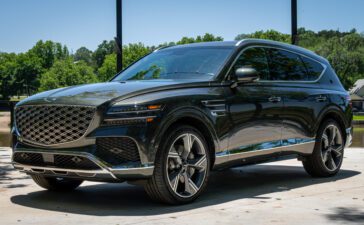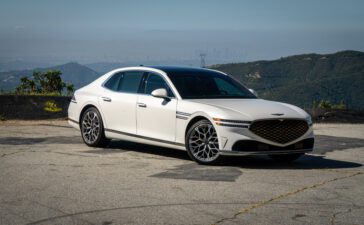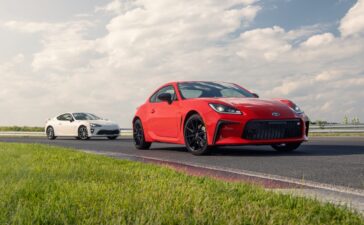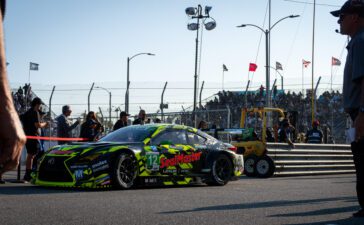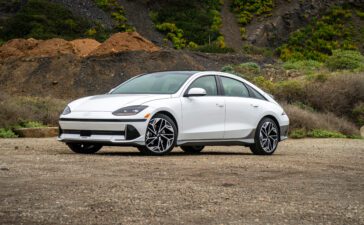As I watch YouTube videos and catch up on my emails, traffic flows around me on the 10 freeway headed east toward Downtown Los Angeles. Eventually, I look up – yep, still bumper to bumper with no hope of respite. I send a few texts, then glance around at the drivers stuck next to me, most driving every bit as distracted as me. If a CHP officer passed, they’d be breaking the law. Not me, though, because I’m behind the wheel of an all-electric EQS equipped with Mercedes-Benz’s new Drive Pilot system.
Mercedes recently brought a fleet of cars out to LA hoping to show media the industry’s latest and greatest in the inevitable, yet sluggish, crawl toward self-driving vehicles on public roads. Benz also brought a team of engineers along to answer any questions we might come up with while testing the first and only Level 3 system approved for use in the United States — and yes, there were many questions worth asking and answering.
What’s the difference between Level 1, 2, and 3 autonomous driving?
Before I let a German robot pilot me around the universe’s main hub for rush-hour traffic, I spent some time giving myself a quick primer on what exactly the autonomous driving levels 1 through 5 actually mean. And the differences bear repeating to fully comprehend Mercedes-Benz’s achievement as the first automaker to earn official Level 3 approval (at least in California, but more on that later).
Levels 1 and 2 are already commonplace: Level 1 is either adaptive cruise control or lane keep assist programs that still require a human driver’s hand on the wheel while Level 2 is able to take on multiple functions of steering, acceleration, and braking with a human’s oversight still present. Tesla’s Autopilot and GM’s Super Cruise, for example, qualify as Level 2 autonomy — though systems that can manage a lane change are now sometimes called Level 2+.

Level 3 ups the ante into a realm much nearer to true autonomous driving, albeit bounded by very tightly defined scenarios. On paper, Mercedes-Benz calls Drive Pilot “SAE Level 3 conditionally automated driving” to satisfy the requisite legalese. In short, that means the system will only work on some roads, at some speeds, and within frameworks that clearly delineate risk management and liability for the system hardware, software, and programming.
To an extent, Level 4 remains somewhat theoretical, taking the onus off the driver entirely and letting the car intervene in every scenario. A human can still override in the case of emergency, though — think robotaxis and delivery shuttles undergoing tests across the planet for the past few years. Level 4 only exists currently in certain parking garages in Germany, which are very controlled environments, to say the least.
Level 5, meanwhile, is the full dreamboat, with no driver required and possibly not even steering wheels or pedals in the vehicle. We’re talking full robotic overlords — a new world order that will likely require separate roads with no humans to throw off the synchronized dance too much.
To clarify, the technology to enable Level 5 autonomy already exists. While Tesla led the charge (pun fully intended) toward Level 2, Elon Musk’s vision was limited (literally) by using only video-based analysis of road conditions. Level 3 so far requires more detection hardware, in Mercedes-Benz’s case a combination of stereo multipurpose camera angles to simulate three-dimensional vision, along with long-range radar that scans the road and environment using electromagnetic waves, and long-range lidar that scans with swiveling laser beams at various heights. The combined radar, lidar, video, and even audio (to detect far-off emergency sirens) includes many hardware redundancies to prevent a single failure from bricking the system or causing potential gaps in analysis that might lead to an accident.
Which Mercedes-Benz models come equipped with Drive Pilot?
Benz’s backups and redundancies run the gamut, from two separate electric steering motors to double ECUs, a rear camera dedicated to emergency vehicle overtaking, microphones inside the cabin, a new antenna for satellite positioning accurate to one centimeter, maps that take into consideration continental shift over time, and even a road moisture sensor that detects the sound of water within the front wheel arches. Model year 2024 EQS and S-Class cars will be available with the suite beginning in early 2024 — surprisingly, at no additional cost upfront.
Actually using the hardware requires committing to a subscription of $2,500 per year, though, and only customers in California and Nevada get the option because Drive Pilot is only approved in those two states. To achieve that certification, Mercedes-Benz mapped out over 100,000 miles of testing in California within what engineers called Drive Pilot’s “operational design domain” (ODD), which means on freeways where stop-and-go traffic is common. Challenges included teaching the computer to recognize lane stripes versus reflective dots, mapping GPS locations for multi-level freeways, and sorting out the proper use of carpool lanes.
The California Highway Patrol actually worked closely with Mercedes to develop the system and even requested a potentially novel turquoise light visible outside cars using Level 3 programs so that emergency responders can identify what they’re dealing with more easily. Nevada, on the other hand, only required self-certification (because of course, it’s Nevada).
Drive Pilot’s ODD requires speeds below 40 miles per hour, clear lane markings, not too much road curvature, clear weather and lighting conditions, and a high-definition map to be available in the system’s memory. Mercedes declined to confirm exactly how many miles within California and Nevada the system currently covers, though, presumably because the stat will pale in comparison to Autopilot or Super Cruise.
How to use Drive Pilot
Many fewer miles might sound less than ideal in headlines, but Drive Pilot theoretically delivers an entirely different level of capability. So how well does it work? I got assigned an EQS at random, with a quiet, knowledgeable engineer in the passenger seat. First, we watched a mandatory educational video on the large center console screen, which all customers will need to complete before being allowed to activate Drive Pilot. Then I purposefully drove us into rush-hour traffic headed towards Downtown LA from Santa Monica — exactly what I try to avoid on a Friday afternoon. As soon as we hopped on the 10, we hit a bumper-to-bumper jam. Perfect!
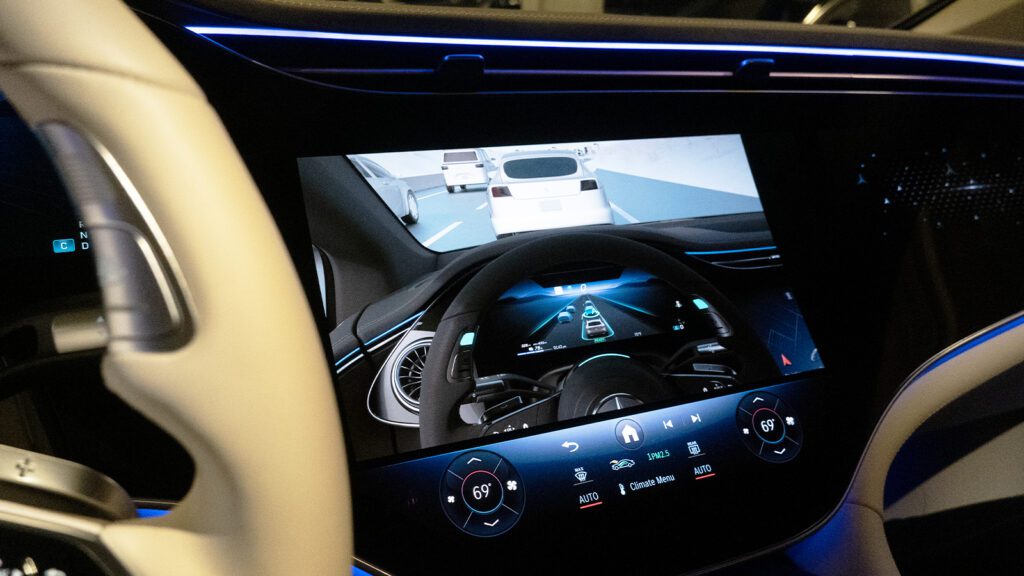
The EQS immediately recognized the situation and blue lights above the two buttons on the steering wheel lit up. The gauge cluster also prompted the fact that Drive Pilot was now available. I touched the button and slowly felt the steering wheel begin to shift underhand. Hesitant, of course, I hovered for a few seconds to make sure everything stayed hunky-dory. Then I laughed.
After all, at this point, we’re not too far removed from the Level 2 systems I’m used to testing. But for those, I can usually count to only 10 seconds before the cars start dinging for me to give the steering wheel a nudge with my hand and fake like I’m paying attention. Not so here. Time to mess with robots, then.
Trusting the ghost in the machine
First, I picked up my iPhone to see exactly how distracted Mercedes believes is too distracted. No problem, until I essentially buried my face in the phone to the point that the infrared eye-tracking system could no longer detect my eyes for an extended period. Ding ding, time to take over driving again. After a few seconds with my hands on the wheel, the blue lights illuminated again and I ceded control back to the car again.
Next, I reclined the EQS’s sumptuous seat, which reps had earlier said would cue a warning. Not so, I found, until my eyes once again lost sight of the infrared camera’s viewing angle. Once more I straightened out with my hands on the wheel and activated Drive Pilot. This time around, I put on sunglasses — which the Lexus RX500h I tested earlier this year struggled with during even Level 2 driving. Not the case here.
Finally, I started fiddling with YouTube and pulled up some rally racing videos as a proper distraction. Not only did the Dolby Atmos sound system blast those banshee engines screaming past, but I could click around and fully absorb in finding good vids without Drive Pilot fretting. All the while, the EQS kept a comfortable following distance from the car ahead of me and I even noticed the car almost imperceptibly shifting over in the lane a few times when motorcycles came up from behind while lane-splitting — a uniquely Californian concern for autonomous driving software.
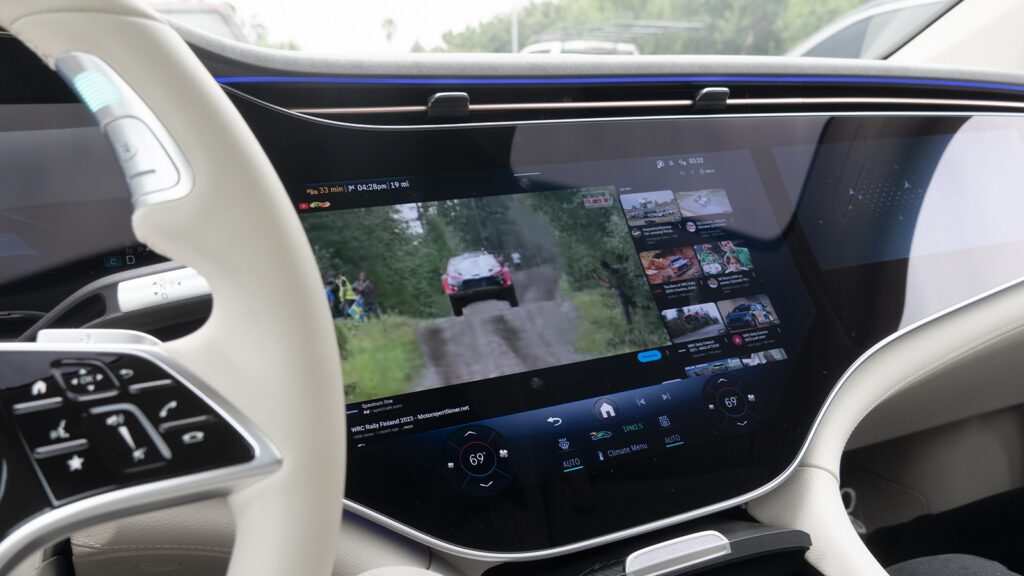
I never pushed the limit much past 30 seconds of dinging, but Mercedes-Benz reps explained that should I have been completely derelict in my duties, videos playing on the center console would have frozen, a yellow message would have lit up, red lights and acoustic warnings would have increased, and then the seatbelt would have jerked for 10 seconds. In the off chance a driver still remains unresponsive, the car will then slow to a standstill while staying in its lane and, assuming a medical issue may be underway, turns the hazard lights on, calls emergency response automatically, and unlocks the doors.
Staying in the lane is a critical point here. But so is the top speed of 40 miles per hour (or 60 kilometers per hour in Germany, where Drive Pilot began customer sales earlier in 2023). If traffic clears up enough for the car to exceed that speed, Mercedes-Benz’s Level 2+ system can initiate, with lane keep and adaptive cruise activated and lane changes allowed up to 85 miles per hour.
Other than the physical hardware and computing power to analyze the data from all those sensors and cameras, Level 3 also requires human programmers to finetune the way Drive Pilot interacts with a human driver. And I found myself almost concerned by how quickly I developed confidence in the Level 3 system. Dropping back down to only Level 2, on the other hand, requires a bit of a mindset shift that needs to be very clearly delineated for the driver — and Benz nailed that transition, too.
We’ve come a long way from Level 1 and 2 autonomy, largely because of the smoothness by which Drive Pilot steers and manages speed. No lurching or sudden braking, no ping-ponging off lines or cracks in the road, no random freakouts in my hour-plus of driving (or riding, I suppose, would be more accurate). I only drove the EQS, though, and no S-Class. Theoretically, an EV might be better for modulating speed and braking.
Theory in practice… and liability
You might have noticed my frequent use of the word “theoretically” to describe many of Drive Pilot’s capabilities. But this is the real world, and autonomous driving theory is now being enacted in real life. I went into this day of testing with Isaac Asimov on my mind, ready to apply the three rules of robotics to the best of my abilities. But Mercedes-Benz clearly designed Drive Pilot’s Level 3 ODD to reduce liability the best it could.
The Mercedes reps I spoke with declined to share any stats about how Drive Pilot’s debut in Germany has performed, other than to say that no major incidents have occurred so far. But we don’t even know how many customers shelled out that annual fee this year. Still, I brought up the classic conundrum: What if the Drive Pilot needs to make a split-second decision between hitting a pregnant mother or two children?
Highly unlikely on the 10 freeway, was the answer, though I’ve seen stranger things — like when I was testing Super Cruise in a GMC Hummer EV and an E90 BMW came crawling across traffic at a full right angle. Super Cruise balked in that scenario and forced me to a full ABS stop in a 9,000-pound brick. Would Drive Pilot pick up the E90 on lidar or radar earlier and response quickly enough? I don’t know, but I do know that the EQS would not leave its lane to miss the BMW in that scenario. The ODD wouldn’t let it.
More realistically, imagine a motorcycle cuts into the lane without signaling and brakes hard. Driving 40 miles per hour, would Drive Pilot slam on the brakes and risk being hit by a hypothetical semi truck following too closely behind? Probably, because that would put liability on the semi-truck driver even if the resultant accident would be more damaging than swerving into the side of an SUV in the next lane while avoiding the motorcyclist.
But therein lies the big question: liability. Even if Drive Pilot was truly programmed with liability in mind, who exactly makes the final determination of liability in the case of an accident becomes a critical question.
The liability question fits into the definitions of Level 2 and 3, to an extent: In Level 2, the driver is responsible but for Level 3, the vehicle is responsible. As long as the driver uses a Level 3 system as intended — which does require keeping the car well maintained so that all the hardware and software can operate as intended — then if the system fails, Benz is on the hook.
I asked whether Drive Pilot records the passenger compartment video to make sure that drivers didn’t cause problems. Apparently not. Next, I can’t help but wonder whether insurance companies will be happy sorting out the blame game when robots and massive multinational conglomerate legal teams get into the mix. Sure, California and Nevada (well, Nevada sort of) legally approved Level 3 in such strict scenarios, but we all know how these things play out when big money enters the picture.
For Benz, the next step for Drive Pilot will involve ramping up to 80 miles per hour in Level 3, exponentially increasing the following and stopping distances. Therefore video, radar, and lidar range are required. But then the system will work for real road-tripping, rather than requiring a step back down into Level 2+ (even if Level 2+ works quite well, too).
For me, the most important question only came to mind after the fact. I’m competitive with the robots that will one day take over my driving duties, so I need to know: In an EQS, does Drive Pilot improve EV range versus a smooth, conscientious human driver? Answering that question will require much more testing, but for now, the future of autonomous driving is here — in an admittedly limited, yet still very impressive, capacity.


